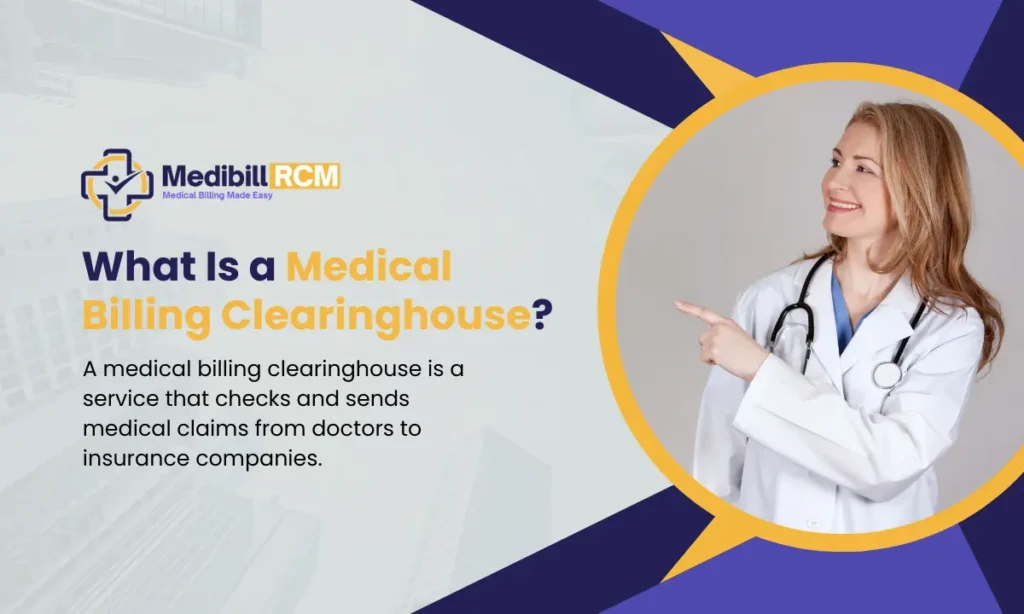For healthcare providers, claim rejections delay revenue and drain resources. Clearinghouses solve this by securely standardizing, validating, and transmitting claims between providers and payers. They bridge the gap between clinical documentation and payer compliance by fast-tracking reimbursement.
Table of Contents
What Is a Clearinghouse in Medical Billing?
What is the definition of a medical billing clearinghouse?
A medical billing clearinghouse is a service that checks and sends medical claims from doctors to insurance companies. It helps find errors, format the data correctly, and ensure claims are delivered safely and quickly.
What function does a clearinghouse serve in electronic healthcare transactions?
It converts claim files into standardized formats (like EDI 837), checks them for errors, and ensures compliance before submission to the payer.
What are the key classifications of medical billing clearinghouses?
Medical billing clearinghouses are classified based on regulatory and technical standards:
- HIPAA-compliant: Protect patient data and follow federal privacy rules.
- EDI-compliant: Use Electronic Data Interchange to transmit claim data.
- ANSI X12 certified: Follow specific formats for healthcare transactions.
- Registered HINs: Act as Health Information Handlers for secure data exchange.
Learn More: Top 10 Clearinghouses in Medical Billing 2025: Best Picks for Fast Claims & Fewer Denials
How Does a Clearinghouse Work in Medical Billing?
How does data move between providers, clearinghouses, and payers?
Here’s the basic clearinghouse workflow:
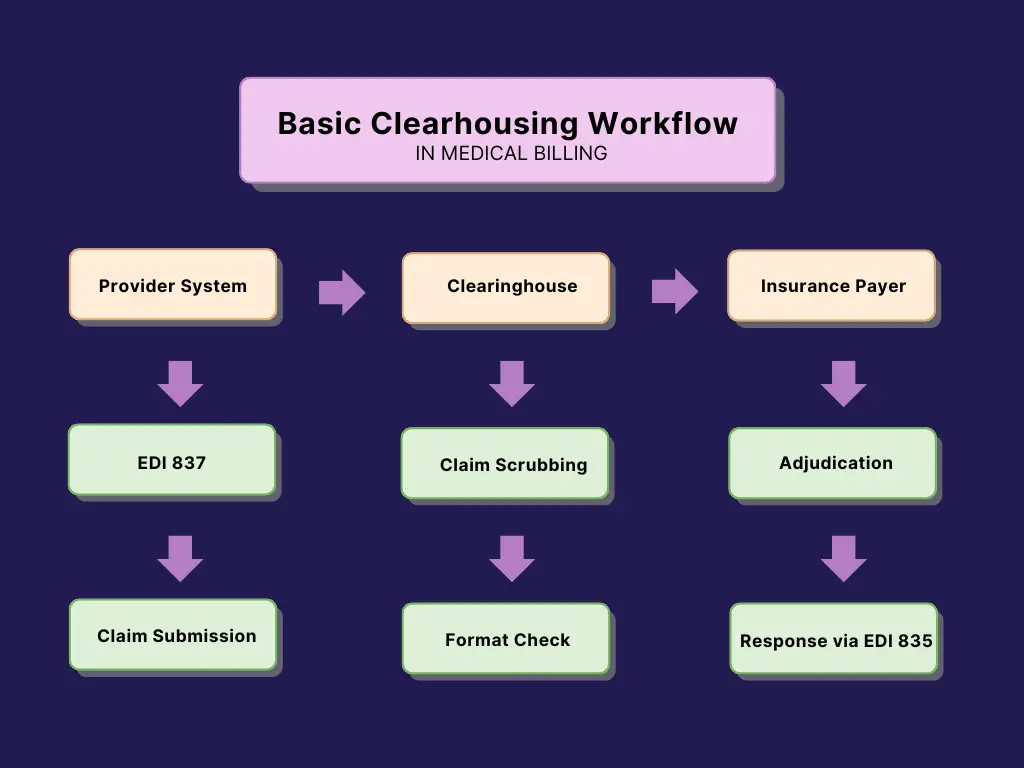
What data formats do clearinghouses process?
Clearinghouses handle standardized EDI formats for healthcare transactions:
- EDI 837: Sends healthcare claims (Professional, Institutional, Dental)
- EDI 835: Receives payment and remittance advice
- EDI 270/271: Manages eligibility checks and responses
What is the claim processing workflow through a clearinghouse?
The medical claim processing workflow includes the following:
- Collect claim data from EHR or practice management software
- Validate and scrub for coding, patient info, and payer rules
- Convert to X12 format for HIPAA compliance
- Transmit the claim to the insurance payer
- Return responses like remittance advice or rejections to the provider
Learn More: How Medical Billing Clearinghouses Work? A Deep Dive into Claim Submission & Processing
Why Are Clearinghouses Essential in Healthcare Billing?
How do clearinghouses reduce claim rejections?
Clearinghouses reduce rejections by checking claims for missing info, wrong codes, or formatting errors before sending them to insurers.
What are the benefits of real-time validation?
Real-time validation improves claim accuracy by:
- Detecting invalid CPT or ICD-10 codes
- Confirming patient insurance and coverage
- Applying payer-specific rules instantly
Why does standardization matter?
Clearinghouses ensure that all data meets payer guidelines, CMS regulations, and national electronic standards, streamlining billing workflows.
Learn More: Clearinghouse vs. Direct Billing: Which Claim Submission Method Fits Best?
What Are the Core Functions of a Medical Billing Clearinghouse?
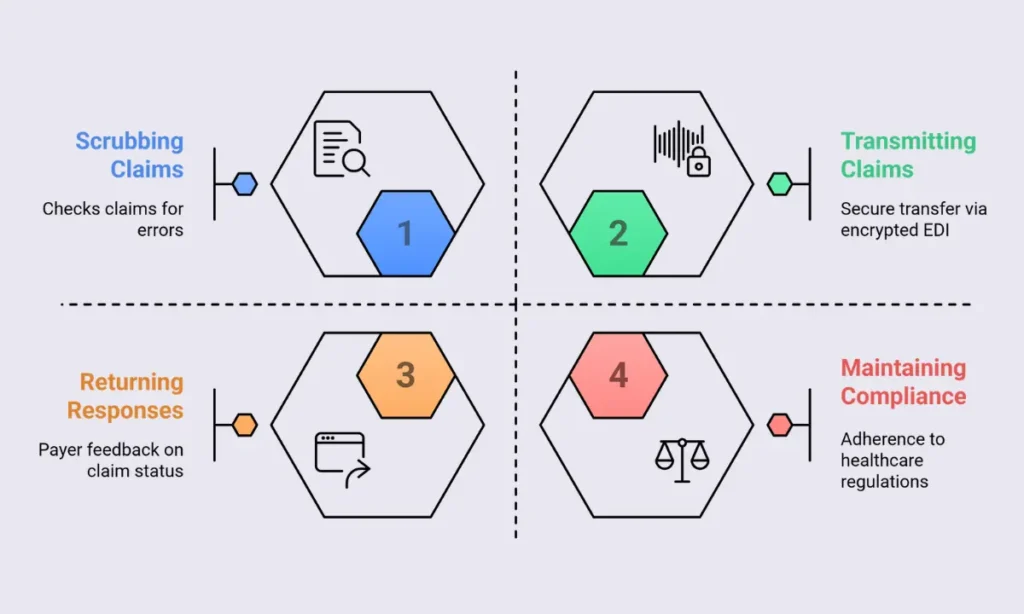
How do clearinghouses support clean claims and payer response handling?
Clearinghouses ensure clean claims and manage payer responses through:
- Claims Scrubbing for errors in codes, structure, and NPI mismatches
- Transmitting claims securely via encrypted EDI formats
- Returning payer responses like rejections, remittance advice, and payment updates
- Maintaining compliance with HIPAA, HITECH, and ANSI X12 standards
Example: A clearinghouse scrubber tool catches a CPT code error before submission, avoiding a rejection and speeding up reimbursement.
How Do Clearinghouses Improve Revenue Cycle Management?
How do clearinghouses optimize reimbursement timelines?
Clearinghouses speed up payments by reducing manual edits and resubmissions, allowing faster and more accurate claim approvals.
What are the benefits of revenue cycle management?
- 20–30% increase in first-pass claim acceptance rates
- Lower denial rates via pre-submission validation
- Faster remittance through real-time EDI response delivery
- Real-time claim tracking and status reporting
- Integrated analytics tools for payer performance and delay detection
What Is the Role of Clearinghouses in Data Security and Compliance?
How do clearinghouses ensure data security in medical billing?
Clearinghouses protect sensitive data by:
- Encrypting claims using TLS/SSL protocols
- Controlling access with role-based security systems
- Logging activity through audit trails and transaction records
Example: In 2020, a healthcare system using an outdated claims portal experienced a breach. Providers using modern clearinghouses with encryption and MFA avoided exposure, proving the value of encryption in preventing PHI leaks.
How do clearinghouses meet HIPAA & HITECH compliance?
- Secure access to protected health information (PHI)
- Complete transmission and access logs
- Regular compliance audits
Learn More: How Do Healthcare Clearinghouses Maintain HIPAA Compliance?
What Is the Relationship Between Providers, Clearinghouses, and Payers?
What model defines this communication flow?
The relationship follows a three-party intermediary model: the clearinghouse connects providers to payers.
What are the key touchpoints in this workflow?
- Claim submission from provider to payer
- Error correction and re-submission if needed
- Remittance posting and denial management
How do clearinghouses integrate with provider systems?
Clearinghouses connect to EHRs and practice management tools via APIs or HL7 interfaces, allowing real-time claim data exchange.
What are the benefits of using a clearinghouse in healthcare?
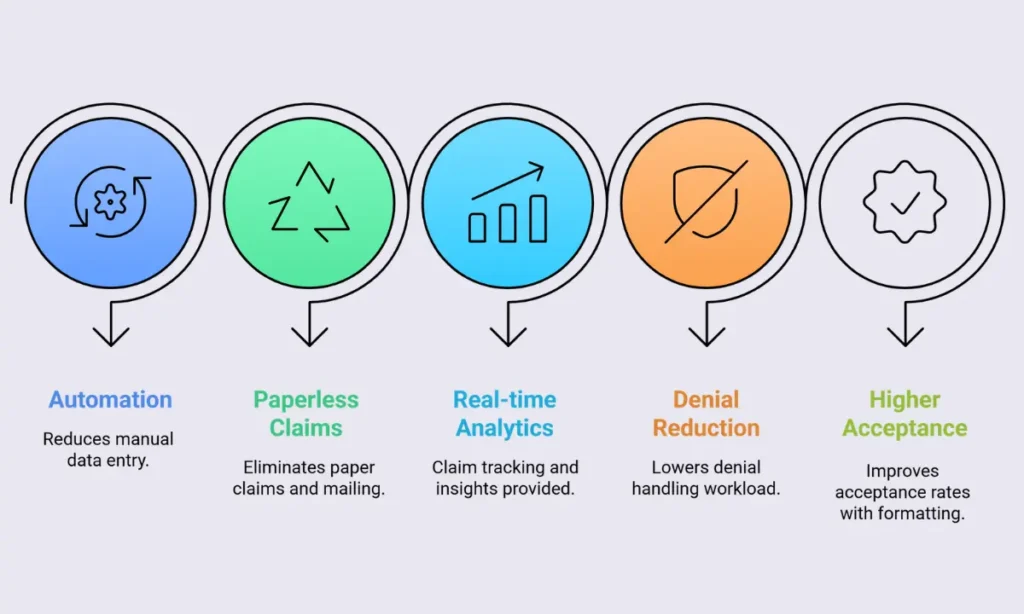
Why do providers choose clearinghouses?
Providers use clearinghouses to streamline billing, cut costs, and improve accuracy through:
- Automation that reduces manual data entry
- Elimination of paper claims and mailing expenses
- Real-time analytics for claim tracking and insights
- Lower denial handling workload through pre-checks
- Higher acceptance rates with payer-specific formatting
Real-world impact: Switching to EDI claims processing cuts claim handling time by 30–40%, boosting efficiency and revenue speed.
Struggling with Denials or Slow Payments?
Let Medibill RCM LLC a Top RCM Medical Billing Company handle your medical billing, coding, and credentialing. Our experts reduce rejections by 30% and accelerate reimbursements so you can focus on patient care.
Contact Us Today
How do clearinghouses contribute to Standardization in Medical Billing?
How do clearinghouses unify claim formats?
Clearinghouses standardize claims by converting all submissions into HIPAA-compliant EDI 837 files, no matter the source system.
What standards and rules do they apply?
- ICD-10, CPT, and NPI validation for national compliance
- Payer-specific rules (e.g., Blue Cross, Aetna, Medicare)
- Support for new code sets like ICD-11 or CPT updates
Impact: This creates consistent billing practices and ensures faster, smoother transitions when regulations or codes change.
What are the challenges of using Medical Billing Clearinghouses?
What are the most common issues providers face?
- Cost: Monthly fees or per-claim charges can add up
- Integration complexity: Custom EHR setup may be required
- Payer limitations: Some insurers don’t accept all clearinghouses
- Learning curve: Staff may need training on new tools and processes
What are effective mitigation strategies?
- Select clearinghouses with wide payer acceptance
- Work with vendors offering integration help and onboarding support
What are the Criteria for Choosing a Medical Billing Clearinghouse?
Use this checklist to compare and evaluate clearinghouses:
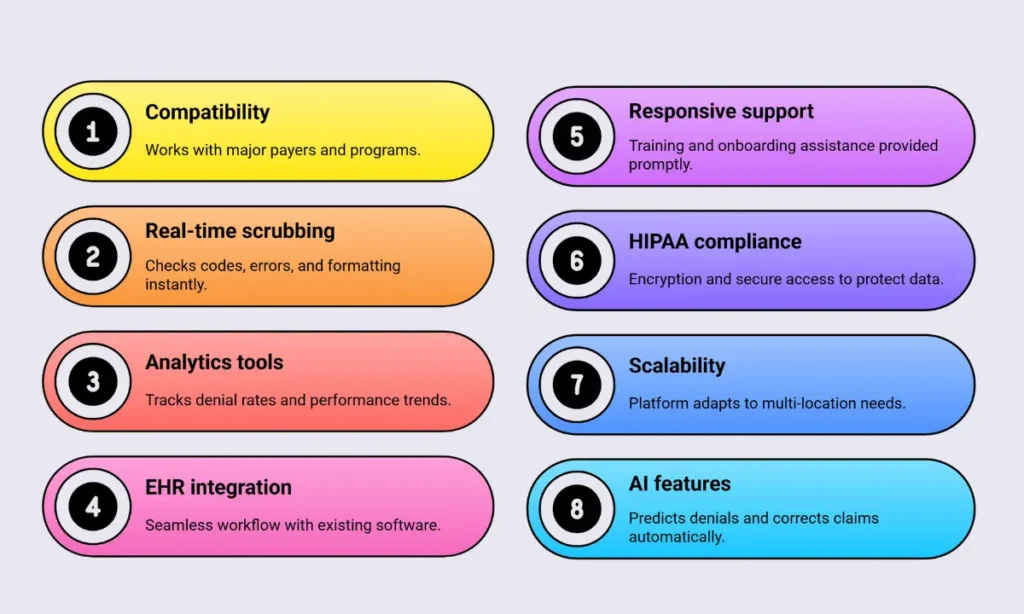
✅ Compatible with major payers, Medicare, and Medicaid
✅ Real-time scrubbing for codes, errors, and formatting issues
✅ Analytics tools for tracking denial rates and performance trends
✅ EHR/practice software integration for seamless workflow
✅ Responsive support with training and onboarding
✅ HIPAA-compliant with encryption and secure access
✅ Scalable platform for multi-location or enterprise needs
✅ AI-based features for denial prediction and claim correction
Example Vendor Comparison
| Feature | Basic Clearinghouse | Advanced Clearinghouse |
|---|---|---|
| Real-Time Claims Scrubbing | ✓ | ✓ + AI-Powered |
| Payer Rules | Generic | Custom (e.g., BCBS TX) |
| Denial Analytics | Basic Reports | Predictive Analytics |
| Support SLA | Business Hours | 24/7 + Dedicated RCM |
Modern trend: Advanced clearinghouses now use AI to flag high-risk claims, reduce denials, and boost claim success rates in revenue cycle management.
Final Thoughts on Medical Billing Clearinghouses
Choosing the right clearinghouse directly impacts payment speed, claim accuracy, and financial performance.
With the right partner, providers can:
- Automate compliance with real-time validation and formatting
- Reduce claim rejections through innovative scrubbing tools
- Enhance visibility with analytics dashboards and tracking
- Accelerate reimbursements by eliminating manual bottlenecks
The right strategy turns billing from a burden into a streamlined, data-driven process.

